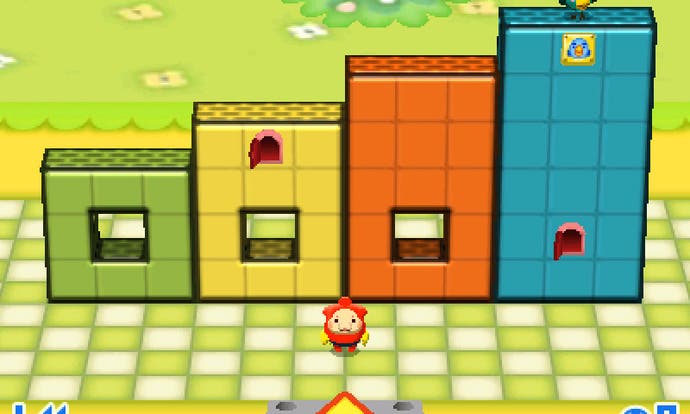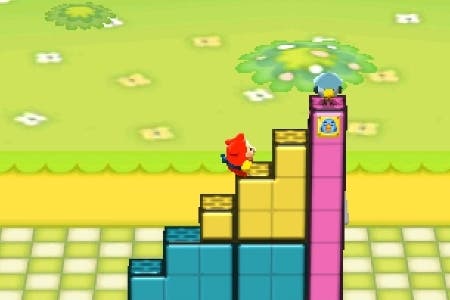Fallblox review
Drag and drop.
Compared to the big hitters that are fighting for your attention this autumn, Fallblox is a mild-mannered affair, having chosen to hide itself deep in the wilderness of the 3DS eShop and offer players nothing more visceral than a wonderfully tactile 3D toy box that you unpack using spatial logic. However, in a weird kind of way, this self-effacing approach only makes the dazzling puzzle creation skills its developers display all the more showy. Like its predecessor Pullblox, Fallblox fairly backs into the limelight - which allows its gently-worn proficiencies to really stand out.
Just look at the casual manner in which it uses a rather simple tweak in the rules to justify an entire new game's worth of challenges. Pullblox saw you moving a funny little guy around brightly coloured sculpture, dragging different layers of, um, blox out of their starting positions in order to create the staircases he needed to reach each level's goal. Fallblox offers the same sort of objective - it's birds rather than stranded kids you're trying to rescue on this occasion - and the same basic pulling and pushing interactions. Second time around, though, gravity's entering the mix, and you now have to think about how block stacks will collapse around you as you work.
The physics are playfully - yet consistently - peculiar: only the blocks you actually push will move in the direction that you're shoving, meaning that any blocks placed on top will stay put and then fall to the floor when the ground disappears beneath them. If you want to move two or more rows at once, in other words, you'll have to brace the top one so that it moves with the bottom, either utilising part of the bottom block to snag it and carry it along with you or using a third block to push both at once. The original Pullblox was about pushing blocks in and out of the screen as if they were drawers in a desk. Fallblox allows you to drag them in four directions, meaning you can grab them and take them for a walk around the stage if you fancy. (I fancied.)

As with Pullblox, the game doesn't put much friction between you and your task: rewinding your recent actions, zooming out, rotating the camera and getting a new perspective on the landscape - even resetting things completely - are all taken care of with a few taps of the triggers and a prod of the circle pad. Such clear-headedness allows you to focus on the main event, which is working out how to use the blocks together.
How do you move a piece when you're standing on it? How should you push one against another so that only the parts of sculpture you want to move are then shifted around? As the 100-puzzle main campaign ticks along, you'll need to learn how to use one block as a sort of transportation device to shuttle another about without it dropping a level, and you'll need to work out how to catch one block on another as if you're hanging pictures on nails. Pullblox veterans will note that the selection of challenges is quite a bit smaller than the first game's, but it's a lot more varied with it. You have more freedom to manoeuvre your playing pieces and the designers have more freedom to use your freedom to get you into some sticky situations. That's freedom for you, eh?
"Nobody's ever going to buy a Fallblox tie-in novel or watch a mini-series set in the expanded Fallblox universe. Instead, the design team has crafted a playful, ingenious, and admirably economical experience."

A surprising number of early stages can be solved in very few moves, and many more have a lovely internal rhythm to them as you use one block to shift another, say, and then use another to shift that one in turn. As pieces drop into place, you glimpse the patterns the designers have created cascading outwards. You see the pacing and choreography that sets this apart from other block-draggers. You sense the invisible structures of play waiting to be revealed.
You can add gadget blocks to all of that, some of which return, slightly transformed, from the original game. Move switches replace pullout switches, for example, allowing you to jog a block along in a specific direction, while manholes are joined by doorways, set into the fronts of blocks rather than the tops and bottoms. Cloud blocks, meanwhile, provide platforms fixed at a certain height - but not, tantalisingly, in a certain location.
There's perhaps a danger that these gadgets could ruin the playschool purity of the whole enterprise. Once again, however, they manage to fit into the game's simple logic fairly snugly, leaving you with more options and more glorious complications to navigate but little in the way of additional artifice or confusion. They come together to create to a game that's a lot more challenging than the original was, too. After a slightly slow opening, the hints disappear and you're on your own in a landscape of chunky geometry and devious puzzling. The genius of the design, of course, is that when you're stuck, there's almost no penalty for experimentation.

Later stages ask you to playfully deconstruct everything from a chicken to a strawberry in order to find the staircases hidden within them, and you'll walk across a vast grand piano in one of the separate Prototypes stages - a suite of extra-curricular levels that focus on using really thick blocks to make complex shapes. Elsewhere, there's even a puzzle where you have to jump up inside Humpty Dumpty's bottom. There really is something for everyone here!
Finally, the level editor and QR exchange tools return, both of which provide plenty of fun without tugging this compact package out of shape. Fallblox is yet another Intelligent Systems game that seems to truly know its place in the world: it's happy to be a smart little download treat that comes alive for a few minutes every night before bed. Nobody's ever going to buy a Fallblox tie-in novel or watch a mini-series set in the expanded Fallblox universe. Instead, the design team has crafted a playful, ingenious, and admirably economical experience composed of dozens of satisfying moments. It's a game about tidying up, finding order, and making a pocket-sized universe behave the way you want it to.

